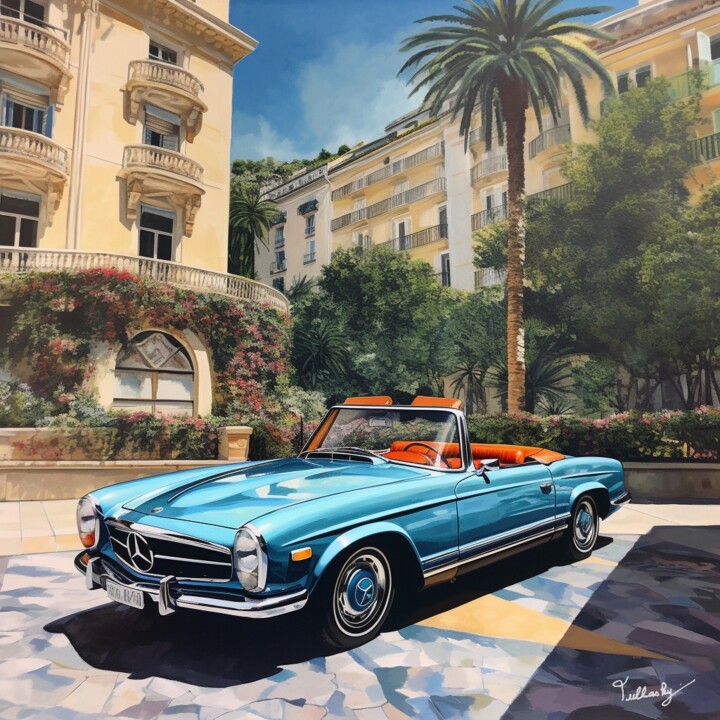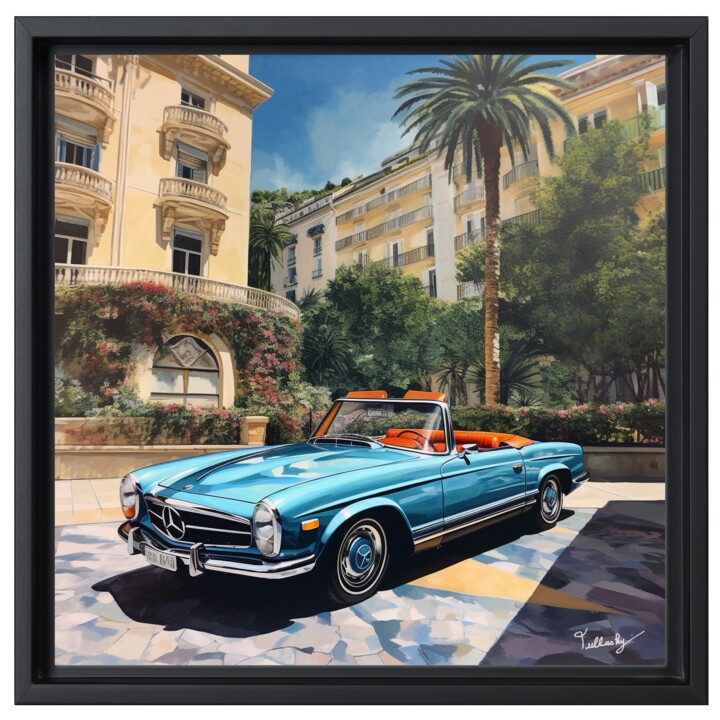



AM2023-56 MERCEDES SL230 PAGODE (2023) Картина - Olivier De Tullasky
Продавец Olivier De Tullasky
«Fine-Arts» печатает на бумаге
Это процесс печати на художественной бумаге с использованием высококачественных пигментных чернил и печати в очень высоком разрешении. Его уровень консервации исключительный (более 100 лет), его качество, глубина и богатство нюансов превосходят классическую фотопечать на аргентинской бумаге.

Глянцевая отделка
Помимо своей исключительной толщины, волокнистая бумага состоит из альфа-целлюлозной основы без кислоты и покрыта сульфатом бария и микропористым слоем, усиливающим поглощение пигментов во время печати. Обладая чистым белым цветом, не желтеет на свету, эта бумага специально разработана для сопротивления и старения. Она используется в крупных музеях по всему миру, поскольку он предлагает отличное разрешение, передавая глубокие и плотные цвета.
Арт Принт "Fine Art" - Глянцевая поверхность на волокнистой бумаге 325 г.

Наши высококачественные печатные издания и репродукции
ArtMajeur использует только натуральную бумагу с нейтральным pH, стойким и высокого качества, отобранную от известных производителей бумаги!
Наш главный принтер уделяет постоянное внимание, будь то с точки зрения контроля цвета или уважения к графической цепочке. Наши высокие требования к качеству являются основным преимуществом художественных репродукций в рамке ArtMajeur.
Для художников! Вы помогаете художникам жить на доходы от продаж своих работ. Они получают гонорар каждый раз, когда Вы приобретаете копии их работ.
О наших гравюрах-
Подлинное произведение искусства (One Of A Kind)
Картина,
Акрил
/
Чернила
/
Карандаш
/
Трафарет
на Холст
- Размеры Высота 23,6in, Ширина 23,6in
- Состояние картины Картина в идеальном состоянии
- Рама Эта работа не оформлена
- Категории Картины до 5 000 $ Поп-арт Автомобиль
This is an original and unique work (this is NOT a reproduction) by the French artist Tullasky.
The artist applies a mixed technique based on inks, acrylic, posca, different varnishes, etc.
The work is mounted on a wooden frame
The rendering is perfect!
A certificate of authenticity accompanies the work which is signed and numbered on the back.
Gloss varnish.
Varnished - Sold NOT framed.
The Timeless Elegance of the Mercedes-Benz SL 230 Pagode
When it comes to classic cars, few models can match the enduring allure of the Mercedes-Benz SL 230 Pagode. Also known as the W113, this iconic roadster graced the automotive scene in the 1960s and continues to captivate car enthusiasts and collectors alike. Let's take a closer look at what makes the Mercedes SL 230 Pagode a timeless symbol of elegance and engineering excellence.
A Timeless Design
One of the most striking features of the Mercedes-Benz SL 230 Pagode is its timeless design. Introduced in 1963, the Pagode was a departure from its predecessor, the 300SL Gullwing, but it managed to establish its own identity and cult following. Designed by Paul Bracq and Bela Barenyi, the Pagode featured clean lines, a low-slung body, and distinctive concave hardtop, giving it a look that was both elegant and sporty. Its design was so successful that it remained virtually unchanged throughout its production run until 1971, a testament to its enduring appeal.
Engineered Excellence
Beneath the Pagode's elegant exterior lies a marvel of engineering excellence. The Pagode was available with a range of inline-six engines, including the 2.3-liter version that gave the car its name, the SL 230. With fuel injection technology, it produced a respectable 150 horsepower, providing a spirited driving experience that combined power with refinement. The suspension system, featuring independent rear suspension, offered a smooth and comfortable ride, making it a true grand tourer.
Open-Air Motoring
One of the key highlights of the Mercedes SL 230 Pagode was its convertible top. While many cars of the era featured soft tops, the Pagode's innovative concave hardtop, combined with its ability to be converted into a roadster, set it apart. The removable hardtop could be replaced with a soft top when the sun called for open-air driving. This versatility made it an ideal car for both sunny summer days and inclement weather.
A Symbol of Status
The Pagode quickly became a symbol of status and sophistication. Celebrities and dignitaries alike were drawn to its blend of luxury and performance. Its comfortable interior featured high-quality materials, wood trim, and a host of modern amenities for its time. Whether cruising along the French Riviera or navigating the streets of New York City, the Pagode made a statement wherever it went.
Legacy and Collectibility
Today, the Mercedes-Benz SL 230 Pagode has cemented its status as a highly collectible classic car. Its timeless design, engineering excellence, and association with a bygone era of glamour make it a prized possession for vintage car enthusiasts. Restored Pagodes regularly command high prices at auctions, and they continue to be a symbol of automotive elegance and nostalgia.
Связанные темы
Olivier de Tullasky vit et travaille à Paris. Il crée une œuvre protéiforme mais toujours colorée, empreinte d'optimisme et de gaîté.
Il y a d'abord les collages. Très liée au "combine painting" initié par l'artiste pop Robert Rauschenberg, cette technique mixte associe le découpage et le collage de milliers de petits morceaux de papiers prélevés dans des revues et magazines, la peinture, ainsi que des dessins aux feutres "Posca". Mêlant références historiques, légendes, art urbain, sa mythologie personnelle convoque des mélanges et compositions variés inspirés de Penfield, des bandes dessinées, des "comics" ou des artistes contemporains. Son œuvre de collages appelle à la déconstruction puis à une reconstruction fine en créant des ensembles qui réconcilient la vie quotidienne et l'art.
Parallèlement, Tullasky compose des peintures (acrylique sur panneaux de bois ou toile) bien souvent combinées à de la matière (farine, plâtre, etc.) qui apporte un relief particulier au support. A noter également ses œuvres « Inside the cell » (acrylique sur toile) de style "pointilliste contemporain" technique qu'il a personnellement développée.
Enfin, il y a ses sculptures disruptives quant aux thèmes et matières choisis : accumulations sur béton, figurines découpées et recomposées, etc.
-
Национальность:
ФРАНЦИЯ

- Дата рождения : неизвестная дата
- Художественные домены:
- Группы: Современные Французские Художники









